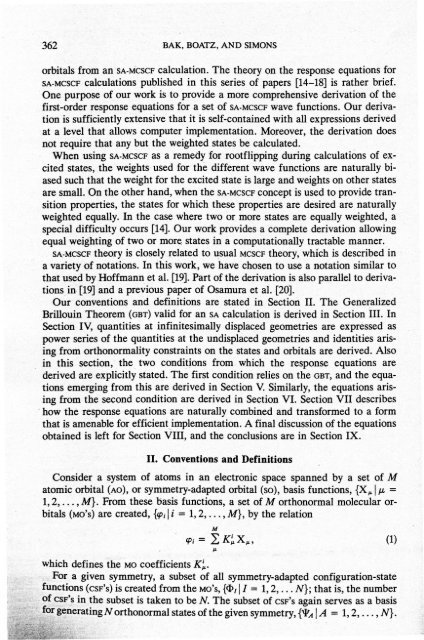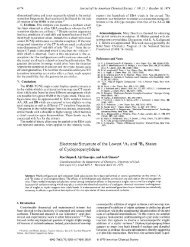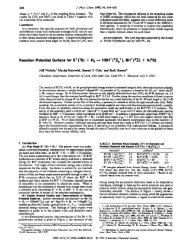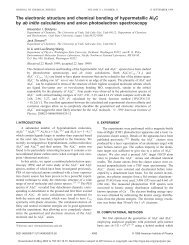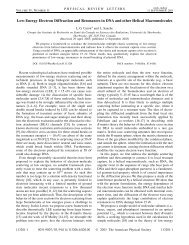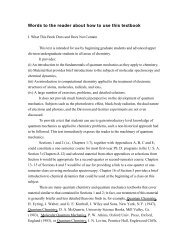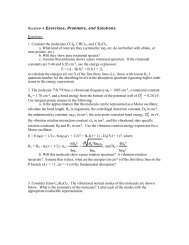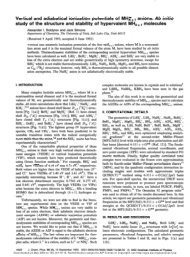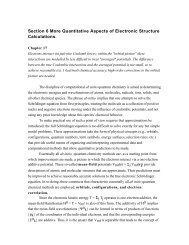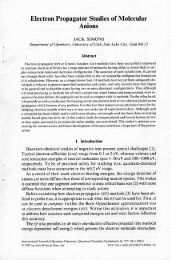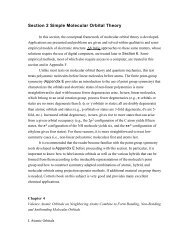First-Order Geometrical Response Equations for State ... - Jack Simons
First-Order Geometrical Response Equations for State ... - Jack Simons
First-Order Geometrical Response Equations for State ... - Jack Simons
Create successful ePaper yourself
Turn your PDF publications into a flip-book with our unique Google optimized e-Paper software.
362 BAK, BOATZ, AND SIMONSorbitaIs tram an 'SA-MCSCF ealeulation. The theory on the response equations <strong>for</strong>SA-MCSCFealeulations published in this series of papers [14-18] is rather brief.One purpose of onr wark is to provide a moce eomprehensive derivation of thefirst-order response equations <strong>for</strong> a set of SA-MCSCFwave funetions. Onr derivationis sufficiently extensive that it is self-eontained with all expressions derivedat alevel that allows eomputer implementation. Moreover, the derivation doesnot require that aDYbut the weighted states be ealeulated. .When using SA-MCSCF as a remedy <strong>for</strong> rootflipping during ealeulatións of excitedstates, the weights used <strong>for</strong> the different wave funetions are naturally biasedsueh that the weight <strong>for</strong> the excited stale is large and weights on other statesare smalI. On the other band, when the SA-MCSCF eoneept is used to provide transitionproperties, the states <strong>for</strong> which these properties are desired are naturallyweighted equally. In the ease where twa or moce states are equally weighted, aspecjal diffieUlty oeeurs [14]. aur wark providesa eomplete derivation allowingequal weighting of twoor moce. states in a eomputationally traetable manner.SA.-MCSCF theory is c1oselyrelated to usual MCSCFtheory,which is deseribed in -a variety of notations. In thiswork, we have ehosen to use a notation similar tothat used by Hoffmann et al. [19].Part of the derivation is also paralleI to derivationsJn-[19]and a previous paper of Osamura et al. [20].aur eonventions and definitions.are stated in Seetion II. The GeneralizedBrillouin Theorem (GBT)valid <strong>for</strong> an SAealeulation is derived in Seetion III. InSection IV, quantities at infinitesimally displaeed geometries are expressed aspower series of the quantities at the undisplaeed geometries and identities arisingtram orthonormality eonstraints on the states and orbitaIs are derived. Also. in this section, the twa eondi~ions from. whieh the response equations arederived are explicitlystated. The fiest eondition relies on the GBT,and the equationsemergingtram this are derived in Section V. Similarly,the equations arisingfrom the seeond eondition are derived in Section VI. Section VII deseribes. how the response equations are naturally eombined and trans<strong>for</strong>med to a <strong>for</strong>mthat is amenable <strong>for</strong> efficient_implementation.A final diseussionof the equationsobtained is left <strong>for</strong> Section VIII, and the eonc1usionsare in Section IX.II. Conventions and DefinitionsConsider a system of atoms in an electronie spaee spanned by a set of Matomie orbital (AO),or symmetry-adaptedorbital (so), basis funetions, {XILIIL=1,2,. .., M}. From these basis funetions, a set of M orthonormal moleeular orbitals(MO'S)are ereated, {'PiIi = 1,2,..., M}, by the relationM'Pi=2: K~XIL'(1)ILwhieh defines the MOeoefficients K~., For a given symmetry, a subset of all symmetry-adapted eonfiguration-statefunetions (CSF'S)is ereated tram the MO'S,{


